|

Hyaluronic Acid
The hyped skin-care product
that does actually reduce wrinkles

Paul May
University of Bristol

Molecule of the Month - October 2021
Also available: JSMol version.

|

As we get old our skin wrinkles, but can this be reversed? |
I’ve heard of that!
It would be difficult not too! It’s been hyped relentlessly as a moisturiser and ‘anti-aging’ remedy in TV and magazine commercials for face-creams for the past several years.
But I assume, as usual, you’re going to tell me it’s all hype and doesn’t actually work?
No, not this time. There’s now a lot of evidence that as an additive in skin cream, hyaluronic acid (HA) does, indeed, act as an excellent moisturiser, and reduces wrinkles by tightening the skin, adding body and plumpness. But...
Ah, I knew there would be a ‘But...’
There’s much less evidence that it acts as an anti-aging remedy. The effects are purely cosmetic (pun intended), in that the skin may look temporarily younger, plumper and more hydrated, but it’s still old skin – as soon as you stop using the cream your skin reverts back to its usual wrinkled, saggy state.
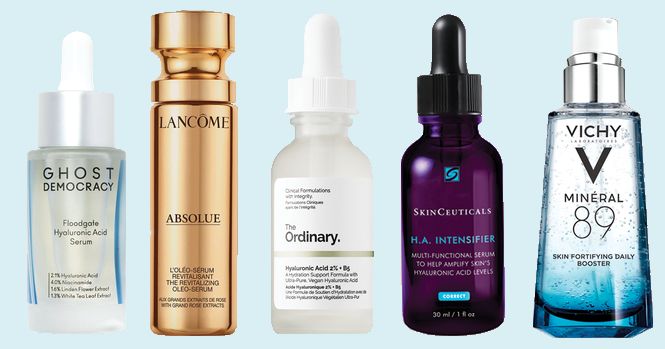
Some of the leading cosmetic creams, gels and treatments containing hyaluronic acid.
[Photo: Good Housekeeping.com]
But what is hyaluronic acid?
It’s a gel-like substance that occurs naturally in the skin, eyes, and joints. Its primary function is to trap water inside tissue cells, keeping the skin and eyes moist and the joints lubricated. Indeed, it is classified as a humectant, a molecule that absorbs water – and can actually bind 1,000 times its volume of water. However, it is also involved in a host of other important biological functions, such as regulating several aspects of tissue repair, e.g. activation of inflammatory cells to enhance immune response, and providing the framework for blood-vessel formation in wound healing. A 70 kg person has ~15 g of HA in their body, one-third of which is broken down and then resynthesized every day.
HA is also a component of the cartilage around joints as well as the synovial fluid surrounding the joints. It is responsible for the tough but spongey nature of cartilage which helps protect the joints from impact damage and abrasion.
|
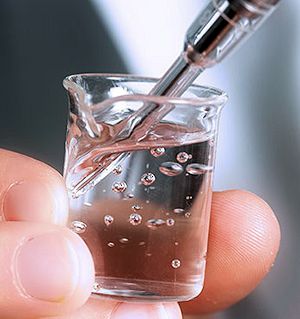
A beaker containing the gel-like hyalorunic aid.
|
Chemically, HA is a poly-disaccharide, which means it’s a polymer (a long chain of molecules joined together) composed of 2 sugar molecules. The first sugar, D-glucuronic acid is similar to glucose (see MOTM for April 2008) in structure and is important for the metabolism of micro-organisms, plants and animals, and is found in many gums such as xanthan gum and gum arabic (both used as food additives). Its name is derived from glucose + urine, from which this molecule, and other related uronic acids were first obtained.
The second sugar, N-acetylglucosamine, is also a derivative of glucose, and is an important component of many biological cell walls, as well as chitin (which forms the exoskeletons of insects and crustaceans) and is the main component of the tough ‘tongues’ of molluscs and the beaks of cephalopods (squids, octopuses, cuttlefish).
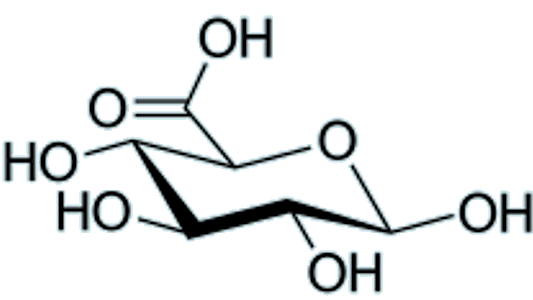 |
 |
| D-glucuronic acid |
N-acetylglucosamine |
HA is simply a polymer of these two sugars, linked alternately as A-B-A-B-A-B- etc., where the chain length (n in the figure below) can be hundreds, thousands or maybe millions of sugars long. It gets its name from the fact that the transparent HA gel was original isolated from the vitreous humour of cow eyes (hyaloid = Greek for ‘glass-like’ or ‘vitreous’) and from its component sugar, D-glucuronic acid.
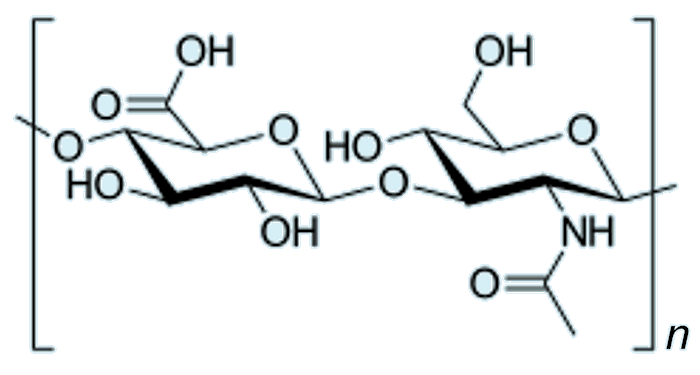 |
| Hyaluronic acid |
A key point about this molecule and its component sugars, is that they are all naturally found in the human body, which means that HA is safe to use in medicines and cosmetics; it is generally well tolerated, it rarely causes allergic reactions or irritates sensitive skin, and is safe to use during pregnancy and while breastfeeding.
So, HA is not just one molecule, it’s several depending on the polymer length?
Yes, quite correct. HA comes in various different varieties, with short, medium and long chains, although rather than length, these are usually defined in terms of their molecular weight in Daltons (where 1 Da = 1 atomic mass unit or 1/12th the mass of a carbon atom). The size of the chosen HA polymer appears to be of critical importance for its various biological functions. High-molecular-weight HA (i.e. > 1,000 kDa) is present in intact tissues and plays a role in suppressing tissue growth and immune responses (which are not needed in healthy tissue). But smaller polymers of HA act as distress signals and induce inflammation and growth of new blood vessels, which are needed if a tissue becomes damaged.
So what’s it got to do with skin wrinkles?
Your skin contains about 50% of all the HA in your body. The HA binds to water molecules, which helps keep the skin hydrated and supple. Levels of HA in the skin significantly decrease as people age, which can lead to dehydrated skin and wrinkles. Taking HA or using cosmetic products that contain it may improve skin hydration and reduce signs of aging.
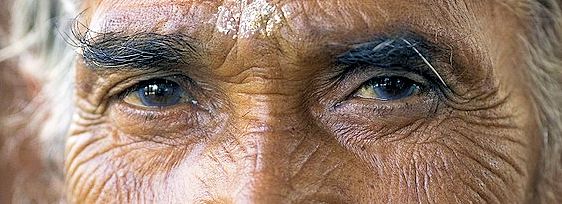
Crow’s feet – wrinkles around the eyes, are caused by aging skin.
[Photo: © Jorge Royan / http://www.royan.com.ar via Wikimedia Commons]
Do all sizes of HA do this?
Ah, there’s the problem. Around the late 1980’s and early 1990’s HA derivatives entered the cosmetics market, claiming to hydrate the skin. But its effectiveness really depends on how much HA is in the formulation, as well as the size of the HA polymer used in the product. Our skin only needs 1-2% of HA to be completely hydrated, so anything greater than this can actually suck up water molecules from surrounding issue or lower down in the skin, drying it out rather than hydrating it. So, moisturising skin creams with high percentages of HA may do the opposite of what they claim!
In terms of HA size, there’s a trade-off. Smaller HA molecules do not bind as much water as larger HA molecules, but they can penetrate deeper into the skin, passing through the outer layer (epidermis) to the deeper layer (dermis) below. In contrast, larger HA molecules bind much more water but cannot penetrate far into the skin; they simply lie on top of the skin only moisturising the epidermis. This layer of HA trapped at the surface feels hydrating at first, but ultimately dehydrates the skin by also drawing up any available water from deeper down.
Is there a way around this?
Yes, scientists have now developed HA formulations which contain a range of different-sized HA polymers - so-called Multi-molecular HA. These have been shown to be effective in hydrating both the epidermis and dermis and for longer time periods. Also, 'nanoHA' treatments have been developed with very short HA polymers containing only a few dozen sugar units, compared to the many thousands in standard HA. It's believed that such small molecules are able to easily penetrate deeply into all parts of the skin.
So, is HA actually anti-aging?
Well, it can reduce the appearance of aged skin, but not reverse it. Human-skin aging is a complex biological process that not yet fully understood, but is really the combination of 2 different processes. First, there is the natural, unpreventable aging process caused by changing body chemistry (e.g. hormone levels), and then there is permanent unrepaired damage to the skin from external factors, such as nutrition, smoking and alcohol consumption, pollution, and UV light exposure. Indeed, approximately 80% of facial skin aging is attributed to UV-exposure!
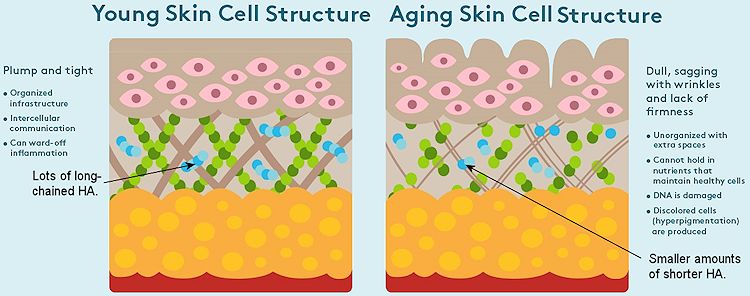
Both the natural aging and external damage processes have similar detrimental effects upon the skin, one of which is the production of reactive oxygen species (free radicals) which can damage tissues, and leads to degradation of the collagen which makes up part of the skin structure, causing loss of elasticity and wrinkling. Another of HA’s properties is that it acts as an anti-oxidant, mopping up these free-radicals and preventing them from damaging the skin.
But skin aging is also associated with loss of skin moisture that’s usually trapped by HA. In aging skin, HA remains deep in the dermis, but disappears from the outer epidermis. Also, as a result of aging, the size of the HA polymers in skin decreases, meaning less water can be trapped. Thus, the epidermis loses the main molecule responsible for binding and retaining water molecules, resulting in the skin becoming dry and wrinkly, as well as losing HA's anti-oxidant properties. Although this missing HA can be replaced temporarily, it does not reverse the natural aging process, although it may slow it down. Even so, HA creams or ointments need to be applied on a regular basis to achieve lasting benefit.
Can HA be used for anything else?
It has been used quite successfully since 1989 as a dermal filler (an injectable fluid commonly used for filling in wrinkles or plumping lips), although these were not official approved for use until 2004. Because HA speeds up wound healing by controlling inflammation and redirecting blood vessels to areas of damaged skin it’s been used to treat diabetic foot ulcers and help them heal more quickly than traditional methods. Biodegradable gels containing HA have also been applied to skin wounds and found to promote wound healing by preventing bacterial infections and moisturising the wound. HA injections have been used to treat osteoarthritis and joint pain in humans and horses. HA has also been used to create artificial tears and as eyedrops to treat 'dry eye'.
|
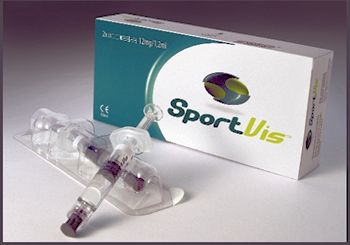
Injections of HA have been used to treat sports injuries such as ankle strains.
[Photo: Mdtintsa, CC BY-SA 3.0 via Wikimedia Commons] |

A rooster comb is a good source of HA!
[Photo: Muhammad Mahdi Karim, GFDL, via Wikimedia Commons] |
How is HA made?
In humans and other vertebrates, HA is made by a biochemical pathway in which enzymes lengthen the HA chain by repeatedly adding the two sugar units to the end of the polymer as it is extruded from a protein. It was first isolated from the vitreous humour in bovine eyes in 1934, and extraction from animal tissue is still one method of small scale production. Surprisingly, the most commonly used animal tissue for extraction of HA is the comb of an adult male turkey or rooster! However, HA from these tissues needs extensive purification to be suitable for human use.
But by far the cheapest and largest scale supply of medical-grade HA nowadays comes from fermenting a type of bacteria which have been genetically modified to synthesise HA, in large ‘brewing vats’. Production of synthetic HA is becoming a very lucrative business. The global market for HA was estimated at $8.9 billion in 2019 and is expected to reach $16.5 billion by 2027!
|
So, what’s the outlook?
It is clear that HA is far more than an inert space-filling molecule that surrounds cells. Its expanding range of uses will make it increasingly important in pharmaceuticals and cosmetics, although more work needs to be done to improve the understanding of the biological role played by the different-sized HA polymers. Synthesising HA polymers with defined-molecular masses may pave the way to building scaffolds for artificial cartilage or bone growth, advanced wound repairs, and anti-cancer treatments. Not bad for a face cream!

Bibliography
- Wikipedia: Hyaluronic Acid; Glucoronic acid; N-Acetylglucosamine
- Meyer K., Palmer, J.W., The polysaccharde of the vitreous humor, J. Biol. Chem., 107 (1934) 629. (First isolation and naming of HA).
- Eske, J. Everything you need to know about hyaluronic acid, Medical News Today (2019).
- Peterson, A. Hyaluronic Acid: Worth The Hype?, Higher Education Skin Care (2019) (History of HA usage).
- Reed R.K., Lilja K., Laurent T.C., Hyaluronan in the rat with special reference to the skin. Acta Physiol. Scand. 134, (1988) 405. (HA in the skin)
- Saedi N., et al. Soft tissue augmentation. In: Bolognia J.L., Jorizzo J.L., Schaffer J.V., eds. Dermatology. (3rd ed. Philadelphia, Elsevier), (2012) 2547. (HA binds 1000 times its volume in water)
- Wiest L., Kerscher M., Native hyaluronic acid in dermatology— results of an expert meeting. J. Dtsch Dermatol. Ges. 6 (2008) 176.
- Klagas I., et al. Decreased hyaluronan in airway smooth muscle cells from patients with asthma and COPD. Eur. Respir. J. 34 (2009) 616.
- McKee C.M., et al. Hyaluronan (HA) fragments induce chemokine gene expression in alveolar macrophages. The role of HA size and CD44. J. Clin. Invest. 98 (1996) 2403. (The role of HA size in biological functions)
- West D.C., Hampson I.N., Arnold F., Kumar S., Angiogenesis induced by degradation products of hyaluronic acid. Science 228 (1985) 1324. (The role of HA size in biological functions)
- McKee C.M., et al. Hyaluronan fragments induce nitric-oxide synthase in murine macrophages through a nuclear factor kappaB-dependent mechanism. J. Biol. Chem. 272, (1997) 8013. (The role of HA size in biological functions)
- Termeer C.C., et al. Oligosaccharides of hyaluronan are potent activators of dendritic cells. J. Immunol. 165 (2000) 1863. (The role of HA size in biological functions)
- Pavicic, T., et al, Efficacy of cream-based novel formulations of hyaluronic acid of different molecular weights in anti-wrinkle treatment, J. Drugs Dermatol. 10 (2011) 990.
- Stern R. Hyaluronan catabolism: a new metabolic pathway. Eur. J. Cell Biol. 83 (2004) 317 (HA turn-over in the human body)
- Meyer L.J., Stern R. Age-dependent changes of hyaluronan in human skin. J. Invest. Dermatol. 102, (1994) 385.
- Longas M.O., Russell C.S., He X.Y. Evidence for structural changes in dermatan sulfate and hyaluronic acid with aging. Carbohydrate Res. 159 (1987) 127. (Shortening of HA in skin with age).
- Papakonstantinou, E., Roth, M., Karakiulakis G., Hyaluronic acid: A key molecule in skin aging, Dermatoendocrinol. 4 (2012) 253.
- Pilkington, S.J., Belden, S., Miller, R.A., The Tricky Tear Trough - A Review of Topical Cosmeceuticals for Periorbital Skin Rejuvenation, J. Clin. Aesthet. Dermatol. 8 (2015) 39.
- Lee, M., et al, Hyaluronic acid dressing (Healoderm) in the treatment of diabetic foot ulcer: A prospective, randomized,placebo-controlled, single-center study, Wound Rep. Reg. 24 (2016) 581.
- Li, X., et al., Effect of the hyaluronic acid‐poloxamer hydrogel on skin‐wound healing: in vitro and in vivo studies, Animal Model Exp. Med. 2 (2019) 107.
- Kolasinski, S.L., et al, 2019 American College of Rheumatology/Arthritis Foundation Guideline for the Management of Osteoarthritis of the Hand, Hip, and Knee, Arthritis & Rheumat. 72 (2020) 220.
- Pucker A.D., Ng S.M., Nichols J.J., Over the counter (OTC) artificial tear drops for dry eye syndrome, Cochrane Database Syst. Rev. 2 (2016) CD009729.
- Vad, V., What Is Hyaluronic Acid?
- Boeriu, C.G., Production Methods for Hyaluronan, Int. J. Carbohydrate Chem., 2013 (2013) 624967.
- Lee, J. Y., Spicer, A.P. Hyaluronan: a multifunctional, megaDalton, stealth molecule, Curr. Opin. Cell Biol., 12 (2000) 581.
- Hyaluronic Acid Market Size - Grandview Research.com


 Back to Molecule of the Month page. [DOI:10.6084/m9.figshare.14636829]
Back to Molecule of the Month page. [DOI:10.6084/m9.figshare.14636829]
![]()
![]()
![]()
![]()









